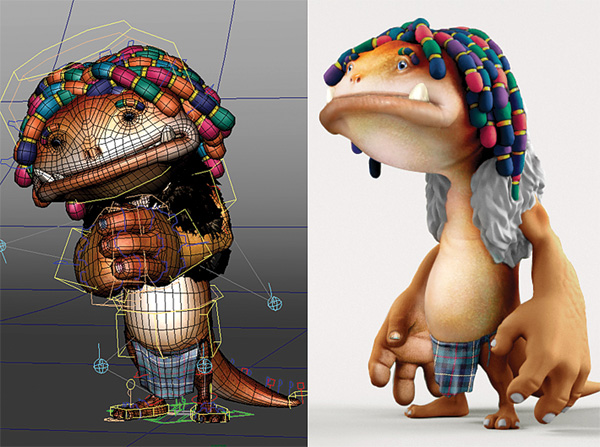
Gügor, before and after.
Images courtesy of Framestore
In an ambitious foray into transmedia, Razorbill, a Penguin imprint, has teamed with special effects company Framestore to produce The Creature Department (2013). The making of the new novel by Robert Paul Weston is a unique collaboration that turns traditional publishing on its head, with Framestore—the Oscar-winning shop behind Harry Potter characters, Kreacher and Dobby, and the Geico gecko—playing an active role in the book’s creation, from conception to execution.
Thanks to Framestore’s talent, Gügor, a Creature Department character resembling an eight-foot-tall salamander with colorful dreadlocks, leapt from the page long before the book’s publication, which involves two children who befriend fanciful beings that work in the “creature department” of an electronics company.
Serving as an ambassador of sorts for The Creature Department, Gügor speaks in a languid voice inflected with a vaguely Southern accent and, in a virtual incarnation, has schmoozed at live events, including Book Expo America. With the book released, Gügor may be available to visit classrooms via Skype, says Razorbill publisher Ben Schrank.
The collaboration is a first for both Framestore and Razorbill—“A leap of faith project” is how Schrank describes it. “Framestore wanted to do a book to see what they could bring to it. I said, ‘What if we agree on a pure collaboration from inception? Let’s bring on a special kind of writer who can do that,’” says Schrank. That was Weston, author of Zorgamazoo (2008) and Dust City (2010, both Penguin).
The team’s approach “wasn’t going to be pure narrative, because that’s not what Framestore does”: What they do well is make creatures, says Schrank. From there, the project was a collaboration. “Rob can write a book,” and “we take a heavy hand here at Razorbill,” he says. “Framestore saw what we were up to and weighed in on what they thought would work and what didn’t.”
The result was a story in which young protagonists Elliot von Doppler and Leslie Fang fight to save the flagging company, DENKi-3000, which is staffed by an unusual group of workers. Weston’s writing is highly visual, allowing readers—and Framestore, during the development process—to get a good sense of how the fanciful characters might look.
Developing The Creature Department
While Weston crafted the characters and the plot, Framestore staff, referring to his descriptions, got to work on the imagery and animation. Designer and illustrator Zack Lydon made rough sketches of characters, including Gügor; his final illustrations appear throughout the book. Lydon also devised a cover concept.
After that, animator Will Frazier used the 3-D animation software Maya to craft a moveable “rig” of Gügor. “It’s kind of like a marionette inside a computer,” Frazier explains. He conceived several gestures for the creature: Scratching his belly, waving, doing a “knuckle crunch,” and more. These movements are used in Web content.
Weston is hard at work on a Creature Department sequel, says Schrank. Though future transmedia aspects have yet to be determined, Schrank maintains that Gügor’s main purpose will continue to be leading young readers to the book.
Is transmedia the direction in which children’s publishing is headed? Somewhat, according to Schrank, who says “We hope to do more with Framestore.” He expects to publish two transmedia projects annually out of Razorbill’s list of 30 original titles. Generally, however, “We look at a book and it tells us what to do,” he says.
In the meantime, Schrank’s aspirations for The Creature Department come down to something very simple: “I hope we have a book that children love.”


